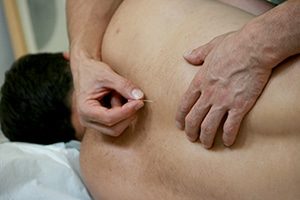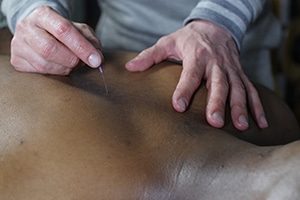Acupuncture is an English word that means to puncture with a sharp object.
In Western medicine, it is used for the relief of muscle pain and tension and is sometimes referred to as dry needling to distinguish it from traditional Chinese acupuncture.
Western medical acupuncture uses a disposable sterile needle, which is inserted into a painful muscle. This action stimulates the nerve pathways that can inhibit pain and reduce muscle tension. It can also promote the release of endorphins.
Dry needling has been used extensively by osteopaths, physiotherapists and chiropractors. It has become a very useful adjunct to traditional manual therapies, as it allows the practitioner to reduce pain and muscle tension quickly and without overusing their hands.
Western versus Chinese Acupuncture Techniques
In the West, postgraduate training for medical professionals tends to focus on the anatomy and physiology of acupuncture and the safe use of needles. Some of the traditional Chinese philosophy is touched on purely for academic interest.
Medical acupuncture or dry needling differs from Chinese acupuncture in that its theory is not based on the flow and balance of energy within the body.
Traditional Chinese medical theory discusses the flow of chi or life force that courses along meridians and can be treated by inserting needles into specific points along its path.
In this context, traditional Chinese acupuncture is used to treat a wide variety of health issues, not just muscle aches. Interestingly, acupuncture is used with great success as an anaesthetic for surgery in China. However, it has not been effective when attempts were made to use it for the same purpose in the West, possibly because of the different belief systems in the patient population.
Despite these differences there is a 70% overlap between traditional acupuncture points and the muscle trigger point maps that were created by doctors Travell and Simons.
In our Notting Hill Studio we practice Western Acupuncture

How Effective is Acupuncture?

Studies into the effectiveness of acupuncture have been of variable quality and reliability. That said, acupuncture has been shown to be effective in the treatment of pain from knee and hip arthritis, tennis elbow, back and neck pain, nausea, dental pain and headache.
Some studies have suggested it has an anti-inflammatory effect via the vagus nerve which suppresses the over-activity of some immune cells. Some literature has also suggested that it alleviates digestive discomfort via the parasympathetic nervous system, which regulates digestive function and opposes the “fight or flight” response.
Acupuncture continues to be a valuable tool used by many osteopaths and other therapists; is a fantastic way to treat myocardial trigger points. Osteopathy and Deep Tissue Massage will help to increase its effectiveness.
The History of Acupuncture
The earliest bone needles were found in China and are thought to date as far back as 6000 BCE.
In 1991 a body was found in the Alps on the border of Italy and Austria. The body was so well preserved that authorities suspected it was that of a relatively recent murder victim.
It turned out to be what is now known as the Oetzi Ice Man – the earliest and best-preserved human body found to date. The body dates back to 5300 BCE. Tattoos were found around the joints of the Ice Man. Scans revealed that these same joints were arthritic and would have been the source of considerable pain. These tattoos are consistent with later records of soot being used to chemically cauterise the wounds following the use of needles made of sharpened bone shards.

Chinese acupuncture was known to European doctors as far back as 1680, but became much more widely known in 1971, when a reporter for the New York Times received acupuncture treatment while in China in preparation for Richard Nixon’s visit in 1972.
Acupuncture gathered more credence in 1973 when endogenous opioids or endorphins were discovered. Now there was evidence that the body manufactured its own supply of powerful opiates that could be released into the bloodstream when required.
Furthermore, research into pain mechanisms showed that stimulating one type of pain-related nerve cell (A Delta nerve fibres) could reduce the amount of pain perceived, by inhibiting the transmission of pain signals in another type of nerve cell (C nerve fibres).
Acupuncture triggers these processes.
Other ancient techniques used the same neurological phenomena, including scarification, blistering, cutting and cautery.
Modern acupuncture also includes techniques like deep needling and electro-acupuncture where a weak electrical current is passed between needles.
